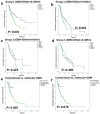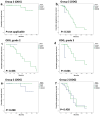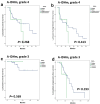Prognostic Impact of TERT Promoter Mutations in Adult-Type Diffuse Gliomas Based on WHO2021 Criteria
- PMID: 38893152
- PMCID: PMC11171308
- DOI: 10.3390/cancers16112032
Prognostic Impact of TERT Promoter Mutations in Adult-Type Diffuse Gliomas Based on WHO2021 Criteria
Abstract
Mutation in the telomerase reverse transcriptase promoter (TERTp )is commonly observed in various malignancies, such as central nervous system (CNS) tumors, malignant melanoma, bladder cancer, and thyroid carcinoma. These mutations are recognized as significant poor prognostic factors for these tumors. In this investigation, a total of 528 cases of adult-type diffuse gliomas diagnosed at a single institution were reclassified according to the 2021 WHO classifications of CNS tumors, 5th edition (WHO2021). The study analyzed clinicopathological and genetic features, including TERTp mutations in each tumor. The impact of known prognostic factors on patient outcomes was analyzed through Kaplan-Meier survival and Cox regression analysis. TERTp mutations were predominantly identified in 94.1% of oligodendrogliomas (ODG), followed by 66.3% in glioblastoma, IDH-wildtype (GBM-IDHwt), and 9.2% of astrocytomas, IDH-mutant (A-IDHm). When considering A-IDHm and GBM as astrocytic tumors (Group 1) and ODGs (Group 2), TERTp mutations emerged as a significant adverse prognostic factor (p = 0.013) in Group 1. However, within each GBM-IDHwt and A-IDHm, the presence of TERTp mutations did not significantly impact patient prognosis (p = 0.215 and 0.268, respectively). Due to the high frequency of TERTp mutations in Group 2 (ODG) and their consistent prolonged survival, a statistical analysis to evaluate their impact on overall survival was deemed impractical. When considering MGMTp status, the combined TERTp-mutated and MGMTp-unmethylated group exhibited the worst prognosis in OS (p = 0.018) and PFS (p = 0.034) of GBM. This study confirmed that the classification of tumors according to the WHO2021 criteria effectively reflected prognosis. Both uni- and multivariate analyses in GBM, age, MGMTp methylation, and CDKN2A/B homozygous deletion were statistically significant prognostic factors while in univariate analysis in A-IDHm, grade 4, the Ki-67 index and MYCN amplifications were statistically significant prognostic factors. This study suggests that it is important to classify and manage tumors based on their genetic characteristics in adult-type diffuse gliomas.
Keywords: IDH-mutant astrocytoma; MGMT promoter; TERT promoter; genetics; glioblastoma; oligodendroglioma.
Conflict of interest statement
The authors do not have any conflicts of interest to declare.
Figures





Similar articles
-
The frequency and prognostic effect of TERT promoter mutation in diffuse gliomas.Acta Neuropathol Commun. 2017 Aug 29;5(1):62. doi: 10.1186/s40478-017-0465-1. Acta Neuropathol Commun. 2017. PMID: 28851427 Free PMC article.
-
Clinical implications of TERT promoter mutation on IDH mutation and MGMT promoter methylation in diffuse gliomas.Pathol Res Pract. 2018 Jun;214(6):881-888. doi: 10.1016/j.prp.2018.04.002. Epub 2018 Apr 5. Pathol Res Pract. 2018. PMID: 29650441
-
Clinical insights gained by refining the 2016 WHO classification of diffuse gliomas with: EGFR amplification, TERT mutations, PTEN deletion and MGMT methylation.BMC Cancer. 2019 Oct 17;19(1):968. doi: 10.1186/s12885-019-6177-0. BMC Cancer. 2019. PMID: 31623593 Free PMC article.
-
IDH-mutant diffuse gliomas: tips and tricks in the era of genomic tumor classification.Histol Histopathol. 2023 Jul;38(7):739-753. doi: 10.14670/HH-18-582. Epub 2023 Jan 9. Histol Histopathol. 2023. PMID: 36651583 Review.
-
Biomarker-driven diagnosis of diffuse gliomas.Mol Aspects Med. 2015 Nov;45:87-96. doi: 10.1016/j.mam.2015.05.002. Epub 2015 May 21. Mol Aspects Med. 2015. PMID: 26004297 Review.
Cited by
-
A novel variant of telomerase reverse transcriptase (TERT) associated with risk of glioma in a Korean population.Sci Rep. 2025 Apr 24;15(1):14346. doi: 10.1038/s41598-025-96929-0. Sci Rep. 2025. PMID: 40274858 Free PMC article.
-
SNAI2 cooperates with MEK1/2 and HDACs to suppress BIM- and BMF-dependent apoptosis in TERT promoter mutant cancers.PLoS One. 2025 Jun 25;20(6):e0322961. doi: 10.1371/journal.pone.0322961. eCollection 2025. PLoS One. 2025. PMID: 40560846 Free PMC article.
-
Precision Neuro-Oncology in Glioblastoma: AI-Guided CRISPR Editing and Real-Time Multi-Omics for Genomic Brain Surgery.Int J Mol Sci. 2025 Jul 30;26(15):7364. doi: 10.3390/ijms26157364. Int J Mol Sci. 2025. PMID: 40806492 Free PMC article. Review.
References
Grants and funding
LinkOut - more resources
Full Text Sources
Research Materials
Miscellaneous

